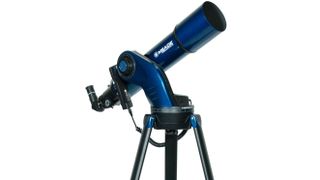Meade telescope and binoculars deals are always worth scoping out and now is the right time to bag a bargain.
In the optics industry, Meade Instruments is a widely-known and trusted name, even if some of their deals can be hard to spot sometimes. We're hoping to see a number of top Meade telescope and binoculars deals. Buying your next bit of stargazing equipment can be a big deal, so we also recommend checking out our guides to the best telescopes, best binoculars, binoculars deals and telescope deals, if you don't find what you want below.
Read more: best budget telescopes under $500
Need an instrument that's easy to use? Read our best telescopes for beginners
Shopping for a young skywatcher? Check out the best telescopes for kids
Below the Meade telescope and binoculars deals you'll see, we've included some buying advice, in case you need a pointer on what to look out for. Naturally, Meade isn't the only manufacturer of quality stargazing equipment out there and we also have specific guides for Celestron, Orion and Sky-Watcher deals.
There's something suitable for every level of astronomer and every budget below and that's because of the quality Meade Instruments provide. We like to keep this page updated year-round and we only source deals from reputable retailers, so if any new deals become available, you'll find them here. So, for the best Meade telescope and binoculars deals out there, read on below.
Which Meade telescope should you buy?
It's crucial that you consider two things before purchasing a new bit of kit, your experience and your budget. If you're trying your hand at astronomy or you're buying for someone new to it all, it's probably best to consider something easier to use and budget-friendly. However, if you're a seasoned stargazer, you could consider a more advanced model, that might offer more, as an upgrade on your current equipment.
Whatever your level of experience though, Meade has a telescope to suit every budget. With the Meade Infinity 60 and Meade Infinity 70 refractors costing less than $100, beginners wishing to skip or upgrade on binoculars are well-placed to improve on their optics without needing to make a large investment. Novice skywatchers with a slightly bigger budget will be able to get improved views with the Meade StarPro 90 and the best-selling Meade Infinity 102.
An increased aperture means there's more ability to collect light, thus improving your views of your night sky targets whether that be moons and planets or fainter nebulas and distant star clusters.
Those with budgets of at least $500 and confidence in using computerized, or GoTo, mounts should certainly give the Meade ETX Observer series a look for clear and crisp views of solar system and deep-sky targets at the touch of a button. The Meade ETX125 Observer, which also offers fully multi-coated optics for high-definition observations, is our personal favorite.
Getting into the $800 to $1000 price range, we head into hobbyist territory. If you’re looking for an upgrade, the optics get even better — we recommend the Meade LX65 6-inch and Meade LX65 8-inch GoTo, of which you can find great deals for on this page.
If you have over $1000 to spend or even a few thousand dollars to the tune of up to $20,000 and skywatching is a serious hobby, Meade offers great deals on superior optics. What’s more, the aperture size increases, which provides even better views of the universe — we recommend giving the Meade LX600-ACF line of telescopes your full consideration.
Which Meade binoculars should you buy?
When it comes to picking the best binoculars for stargazing, getting a good aperture is key. The aperture is the diameter of the objective lens, which are the larger lenses that don't sit next to your eyes, and the bigger this is, the more light will be gathered by your binoculars. This is useful, as it means you'll be able to see dimmer objects in the sky, which are further away, and it also means nearby targets will appear more brilliant.
We'd recommend aiming for an aperture of around 50mm, as this is large enough to gather plenty of light for stargazing. Any bigger than this and your binoculars will become much heavier, which in turn makes them harder to hold still for a good view. You'd probably need some kind of tripod to support anything with an aperture above 50mm, because of the added weight.
When it comes to magnification, we recommend opting for a model with either 8x or 10x. Sometimes going for something with more powerful magnifications can narrow the field of view, which in turn means you don't experience the truly immersive night sky views that you would get in a wider field of view.
When you're considering the optics, we advise you look for models with a Porro prism design, multi-coated optics and have BAK-4 glass. You cant go wrong with these features so it's always worth looking out for. This is what will give you the crystal clear night sky views you're chasing.


